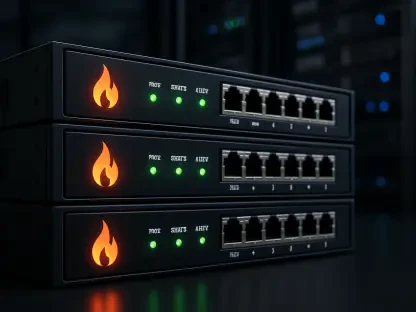In a world where digital threats lurk around every corner, a staggering 18.4 billion data points were leaked in the US alone this year, with over 2 billion tied directly to compromised passwords, painting a grim picture of cybersecurity’s most vulnerable frontier. How can organizations shield themselves when the simplest entry point—a weak password—remains an open door for attackers? The answer lies in a proactive strategy that often gets overlooked, one that could mean the difference between a secure network and a devastating breach.
The Persistent Vulnerability of Passwords
The reality of cybersecurity today is unsettling: despite cutting-edge tools and systems, passwords continue to be the softest target for cybercriminals. Billions of credentials are exposed annually, often due to basic oversights that go unnoticed until disaster strikes. A single reused or outdated password can unravel an entire organization’s defenses, making this issue a pressing concern for businesses of every size.
Attackers thrive on exploiting these weaknesses, using sophisticated methods to crack or steal credentials at an unprecedented scale. The human element—whether it’s forgetting to update a password or using the same one across multiple accounts—fuels this vulnerability. This persistent gap in security demands attention, as the consequences of inaction can be catastrophic for both data integrity and public trust.
Escalating Dangers of Credential Breaches
Data breaches linked to compromised passwords have surged, creating a landscape where no entity is immune to risk. High-profile incidents, such as a recent leak exposing 184 million records from major tech platforms, reveal the sheer magnitude of the problem. These events are not isolated; they reflect a broader trend of attackers leveraging stolen credentials to infiltrate systems with alarming ease.
The reasons behind this escalation are multifaceted, rooted in user habits and evolving cyber tactics. Studies show that 84% of individuals admit to reusing passwords, while only a third update them monthly, creating fertile ground for exploitation. Meanwhile, cybercriminals deploy advanced phishing schemes and brute-force attacks, capitalizing on these predictable patterns to gain unauthorized access.
This growing threat underscores a critical need for vigilance across industries. Small businesses and global corporations alike face the same peril, as a single breach can cascade through interconnected systems. The stakes have never been higher, pushing the urgency to address password security to the forefront of organizational priorities.
Revealing Hidden Threats with Password Audits
Password audits serve as a vital tool to uncover security gaps that often remain invisible until exploited. These systematic evaluations pinpoint issues like duplicated passwords across accounts, dormant admin profiles with unchecked privileges, and outdated authentication protocols that no longer meet modern standards. By shining a light on these risks, audits provide a clear starting point for fortifying defenses.
Consider the impact of undetected flaws: a forgotten service account tied to a past employee could become an entryway for attackers. Audits detect such anomalies, along with credentials already circulating on breach lists, preventing potential disasters before they unfold. This process is not just a precaution but a necessary step to safeguard sensitive data in an era of relentless cyber threats.
The value of this approach is evident in real-world outcomes. Organizations that routinely audit their password systems can avert breaches that might otherwise cost millions in damages and lost credibility. Embracing this practice transforms a reactive stance into a proactive shield, ensuring vulnerabilities are addressed before they are exploited.
Insights from Experts on Proactive Defense
Cybersecurity professionals unanimously agree that passwords represent a critical weak point without deliberate intervention. Industry trends point toward a shift in mindset, prioritizing preemptive measures over damage control after a breach. “Regular audits are no longer optional; they’re a baseline for survival in today’s threat landscape,” notes a leading security analyst, echoing a widely held view among experts.
Tools designed for this purpose, such as Specops Password Auditor, have gained traction for their ability to scan environments like Active Directory for weaknesses. These solutions offer detailed reports on issues ranging from blank passwords to duplicated credentials, empowering teams to act swiftly. Such technology is reshaping how organizations approach security, making audits accessible and actionable.
A hypothetical scenario illustrates the power of this strategy: a mid-sized firm, unaware of stale accounts in its system, conducts an audit just in time to lock down a compromised admin profile before a major attack. This near-miss highlights the tangible benefits of staying ahead of threats. Expert insights and practical tools together build a compelling case for embedding audits into routine security protocols.
Practical Steps to Fortify Security Through Audits
Implementing password audits requires a structured plan that balances robust protection with user convenience. Start by scheduling regular scans of network environments to identify risks like weak or breached credentials, ensuring no stone is left unturned. This foundational step sets the stage for targeted improvements across the board.
Next, consider immediate actions such as enforcing password resets for vulnerable accounts, whether in bulk or for specific high-risk users. Complement this with self-service reset systems that allow employees to update credentials without burdening IT teams. Temporarily locking down accounts with elevated access during remediation can also prevent unauthorized entry during critical windows.
Long-term strength comes from adopting comprehensive policies supported by tools like Specops Password Policy, which block common or compromised passwords while enforcing complexity rules. Educating staff on best practices further reduces human error, fostering a culture of security awareness. These combined efforts create a resilient framework that not only addresses current threats but also prepares for future challenges.
Reflecting on a Path Forward
Looking back, the journey through the landscape of password security revealed a stark truth: vulnerabilities once ignored had grown into formidable risks over time. The staggering scale of breaches had forced a reckoning, compelling organizations to rethink their defenses with urgency. Each exposed credential had served as a harsh reminder of the cost of complacency.
The lessons learned pointed to actionable next steps that could reshape outcomes. Prioritizing regular password audits had emerged as a proven method to uncover and mitigate dangers before they escalated. By integrating advanced tools and fostering user accountability, businesses had begun to turn a perennial weakness into a fortified barrier.
As threats continued to evolve, the commitment to proactive measures had become a defining factor for resilience. Exploring emerging technologies and refining policies offered a way to stay ahead of adversaries. The path forward rested on sustained vigilance, ensuring that the digital fortresses of tomorrow stood stronger than ever against relentless cyber onslaughts.









